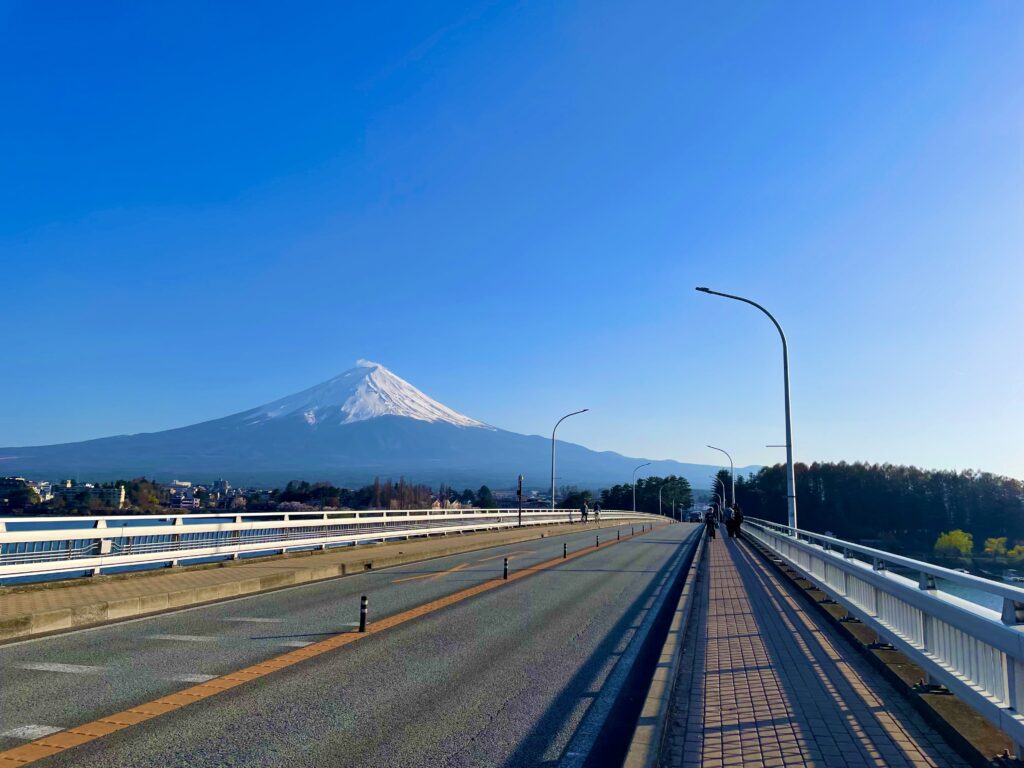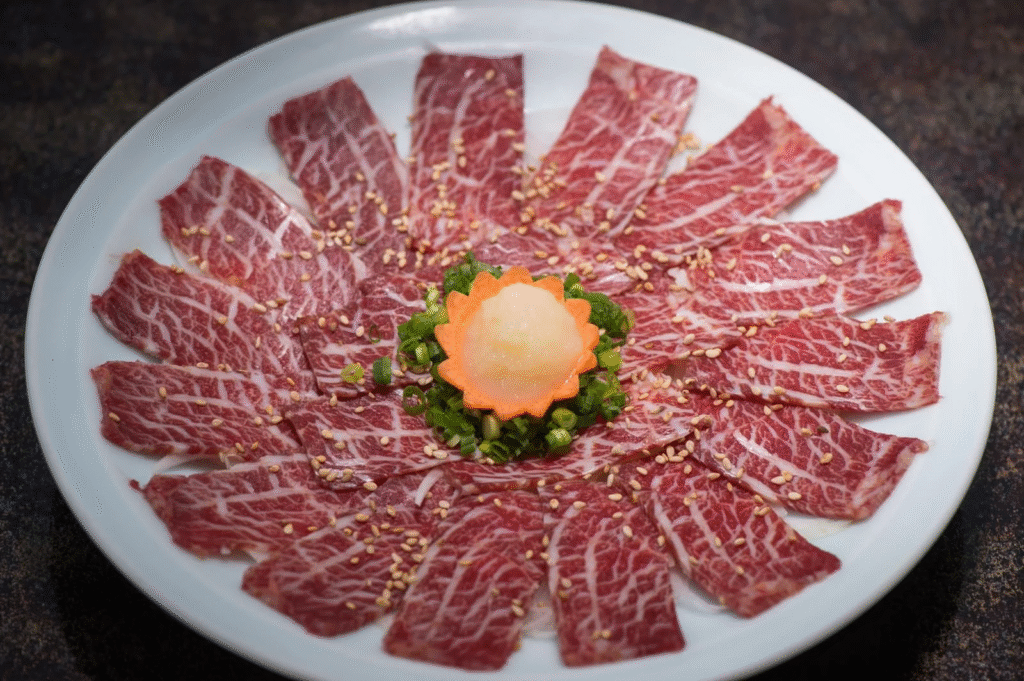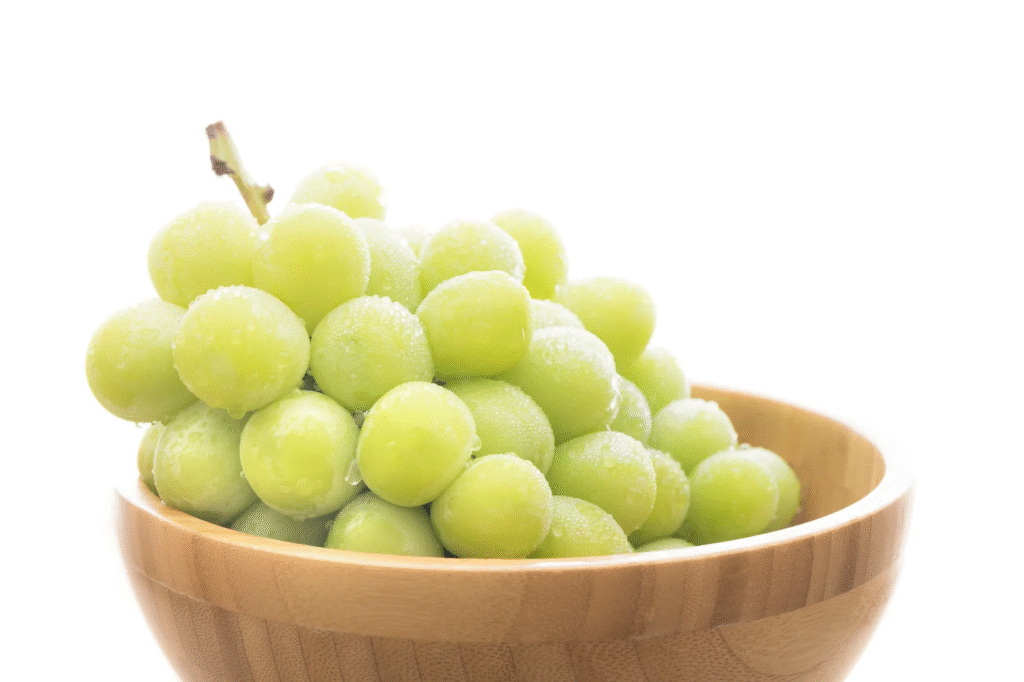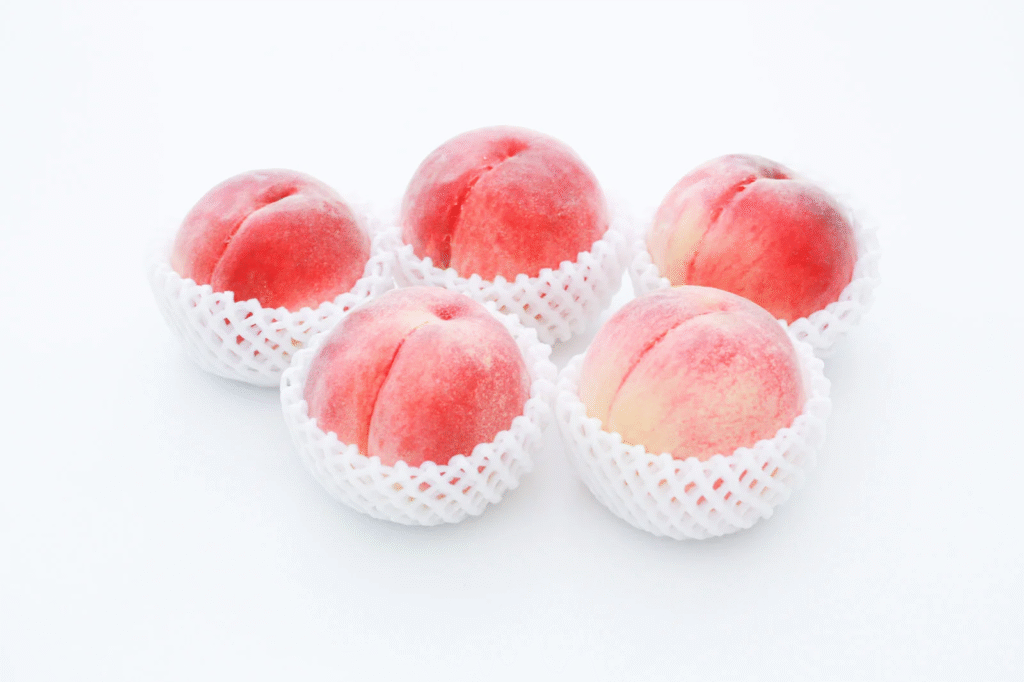Quick Navigation
- 1 Intro
- 2 Yamanashi’s Famous Food Culture
- 3 Must-Try Local Famous Food in Yamanashi
- 3.1 Hōtō – Traditional Flat Noodles in Miso Soup
- 3.2 Yoshida Udon – Thick, Chewy Noodles from Fujiyoshida
- 3.3 Basashi – Raw Horse Meat, Served the Yamanashi Way
- 3.4 Shingen Mochi – A Soft Rice Cake Dusted with Kinako
- 3.5 Shine Muscat Grapes – The Sweetest Luxury Fruit
- 3.6 Yamanashi Peaches – Juicy Summer Delights
- 4 Bonus: Where to Try These Foods (Shops, Cafes, or Events)
- 5 Final Thoughts
Intro
When people think of Japanese food, Tokyo’s sushi or Osaka’s street snacks might come to mind first.
But as someone born and raised in Japan, I believe the real heart of Japanese cuisine is found in the local dishes — the ones you can’t always find in guidebooks or big cities.
That’s exactly what Slow Trip Japan is all about:
a Japanese local sharing the flavors, places, and experiences that make this country special — in English, from the ground level.
Today, I’d like to introduce you to the food culture of Yamanashi, a region near Mt. Fuji known not just for its natural beauty, but also for its rich and often overlooked local specialties.
Now — let’s explore what makes Yamanashi’s local food so special.
Yamanashi’s Famous Food Culture

When most people think of Japanese food, places like Tokyo or Osaka often come to mind first.
But if you’re looking for something truly local — the kind of food that reflects the rhythm of daily life and the flavors passed down through generations — Yamanashi might just surprise you.
As someone who lives near the Fuji Five Lakes, I’ve come to realize how much this area has to offer when it comes to regional food.
From hearty noodles you’ll see on banners outside family-run restaurants, to fruit stands overflowing with freshly picked peaches, the food here isn’t just delicious — it’s a part of local identity.
Why Yamanashi Is a Hidden Foodie Destination
Yamanashi doesn’t shout like the big cities — instead, it whispers with flavor.
The food culture here is built on simple, seasonal ingredients, and many of the best dishes are tied to local traditions or unique geography.
For example:
- You’ll see Hōtō noodles on menus everywhere in autumn and winter — warm, filling, and full of vegetables
- Yoshida Udon is known for its chewiness, and you’ll only find the real thing around Fujiyoshida
- In summer, fruit like Shine Muscat grapes and Yamanashi peaches dominate not just stores, but conversations too (“Have you tried this year’s batch yet?”)
It’s not a gourmet food capital — it’s better.
It’s where you can still eat like the locals do.
When and Where to Enjoy Local Specialties
Timing matters in Yamanashi.
Some dishes and products are best during certain seasons — and that’s part of the fun.
- Hōtō is especially comforting in colder months (and tastes better after a day of exploring)
- Peaches and grapes are at their peak in summer — you’ll spot roadside stalls, supermarket specials, and fruit-picking events everywhere
- Even mochi and sweets change subtly with the seasons
Where to try them?
Sometimes the best meals are at quiet mom-and-pop shops, roadside restaurants, or even at seasonal festivals where you didn’t expect to eat anything special — and end up discovering your favorite new flavor.
Must-Try Local Famous Food in Yamanashi
Hōtō – Traditional Flat Noodles in Miso Soup
If Yamanashi had a soul food, it would be Hōtō.
This thick, flat noodle dish simmered in a miso-based soup has long been a part of home cooking in the region — something you’re more likely to find in a family kitchen than a restaurant.
Locals often make it themselves, especially in the colder months.
It’s the kind of food you eat after coming in from the snow or wind — hot, hearty, and comforting.
A standard bowl of Hōtō includes seasonal root vegetables like pumpkin, leeks, carrots, and potatoes, all stewed together until everything is soft and flavorful.
Recently, you’ll also find creative versions popping up on menus:
- Spicy miso hōtō
- Seafood-style hōtō
- Even hōtō served with a side of tempura
But no matter the variation, it’s still a dish that speaks to Yamanashi’s deep connection to local ingredients and simple, nourishing meals.
Yoshida Udon – Thick, Chewy Noodles from Fujiyoshida

Unlike Hōtō, which is often made at home, Yoshida Udon is a dish people in the Fuji area typically go out for.
It’s known for being cheap, filling, and full of character — a true local lunch favorite.
You can usually find a bowl for around 500 yen, and it comes with plenty of chewy noodles, vegetables, and sometimes meat or tempura toppings.
Locals eat it all year round: hot in the winter, cold in the summer.
The broth is usually a soy sauce and miso mix, but the real standout is the noodles themselves:
they’re thick, firm, and often described as “hard” — but in a good way.
Each shop has its own take on noodle texture, so part of the fun is visiting different places to find your favorite chew.
There are nearly 50 Yoshida Udon restaurants in the Fujiyoshida and Kawaguchiko area alone.
Most are open only for lunch (around 11:00 to 14:00), so timing is key.
One of the most popular spots among Japanese visitors is Menkyokaiden (免許皆伝), known for its incredible flavor and long lines even before it opens.
It’s not just food — it’s a full-on local experience.
Basashi – Raw Horse Meat, Served the Yamanashi Way

If you’ve never tried basashi before — raw horse meat, sliced thin like sashimi — Yamanashi is a great place to start.
While the idea might surprise some first-time visitors, basashi here is known for its clean, light flavor and a slightly sweet aftertaste.
It’s not strong or gamey at all — instead, it’s refreshing, tender, and just a little chewy, which many locals love.
You’ll find it on the menu at many izakaya (Japanese pubs) around Yamanashi, where it’s often served with grated ginger, soy sauce, and thinly sliced onions.
It’s one of those dishes that locals don’t make at home, but regularly enjoy when eating out.
And if you’re open to trying something uniquely Japanese, this is a surprisingly approachable and well-loved delicacy to start with.
Shingen Mochi – A Soft Rice Cake Dusted with Kinako
Shingen Mochi is one of Yamanashi’s most iconic sweets — not just for eating on the spot, but for taking home as a souvenir.
You’ll often see it in train stations, highway rest areas, and specialty stores across the region.
It’s a simple but elegant treat: soft, chewy rice cake dusted with roasted kinako (soybean flour), and usually served with a small packet of sweet kuromitsu (black sugar syrup) to pour over the top.
The result is a lightly sweet, nutty flavor that many Japanese people grew up with — it’s nostalgic, satisfying, and very “Japanese” in taste.
Locals don’t necessarily eat it every day, but they often buy it as a gift when visiting friends or family in other parts of Japan.
If you’re looking for a snack that’s both delicious and deeply tied to local tradition, Shingen Mochi is an excellent introduction to Japanese wagashi (traditional sweets).
Shine Muscat Grapes – The Sweetest Luxury Fruit

If there’s one fruit that captures the taste of summer in Yamanashi, it’s the Shine Muscat grape.
These bright green grapes are known for being luxuriously sweet, refreshingly light, and totally seedless — you can eat them skin and all.
They’re considered a premium fruit in Japan, often given as gifts or featured in high-end fruit stores.
But if you’re in Yamanashi during the right season (from late summer to early autumn), you’ll find them everywhere — from supermarkets and roadside stands to fruit-picking farms.
Once you try them, it’s hard to stop.
They’re crisp, juicy, and have just the right balance of clean flavor and intense sweetness.
Honestly, I’ve found myself eating five or six in a row without even realizing.
Yamanashi produces more Shine Muscat grapes than anywhere else in Japan, and many locals take pride in that fact.
In this region, Shine Muscat isn’t just a fruit — it’s part of the season itself.
Yamanashi Peaches – Juicy Summer Delights

If you visit Yamanashi in July or August, you’re in for a sweet surprise: this region is one of Japan’s most famous producers of peaches — and for good reason.
Thanks to the rich soil, long hours of sunshine, and large temperature swings between day and night, Yamanashi has the perfect natural conditions for growing soft, sweet, and juicy peaches.
They’re not just beautiful — they melt in your mouth with every bite.
Locals love them too.
When peach season hits, you’ll find them everywhere — from roadside stalls to supermarkets and even convenience stores.
It’s one of those fruits that turns up in casual conversations, family dinners, and as seasonal gifts.
If you’re in Yamanashi during the summer and don’t try a peach… you’re seriously missing out.
Bonus: Where to Try These Foods (Shops, Cafes, or Events)
You don’t need to book a food tour or visit a Michelin-starred restaurant to enjoy local flavors in Yamanashi — you’ll find regional specialties in everyday places.
Here’s where I personally recommend trying them:
- Hōtō → Look for small family-run restaurants or roadside eateries around Lake Kawaguchi and Lake Saiko. Especially in winter, many shops proudly advertise their homemade Hōtō with banners out front.
- Yoshida Udon → Fujiyoshida and Kawaguchiko have nearly 50 udon shops. Try Menkyokaiden for a true local favorite — just get there early!
- Basashi → Common on izakaya menus across the region. It often pairs well with local sake or plum wine.
- Shingen Mochi → You’ll find it in souvenir shops at stations like Kawaguchiko or Kofu, and even in convenience stores. It also makes a great gift to take home.
- Shine Muscat & Peaches → Visit a local farmer’s market, fruit-picking farm, or even a supermarket in season. Some fruit stands near orchards offer just-picked varieties that taste incredible.
You might also come across seasonal events and roadside markets that showcase these foods — don’t skip them.
That’s where you’ll really get to feel how food connects with local life here.
Final Thoughts
Taste the Real Japan Through Yamanashi’s Local Food
Yamanashi may not be the first place people think of for Japanese food,
but if you want to experience the flavors that locals actually eat — in homes, small shops, and quiet towns — this is the place to do it.
From a steaming bowl of Hōtō on a cold day to a perfectly ripe peach in the summer sun,
Yamanashi’s food isn’t just about taste — it’s about season, place, and feeling.
Each dish tells a little story of the land and the people who live here.
If you’re someone who loves discovering local culture through what’s on the table,
Yamanashi should definitely be on your foodie map.
More Regional Food Guides from Slow Trip Japan
Curious about what else to try while traveling in Japan?
Here are some more Slow Trip Japan food guides you might enjoy:


